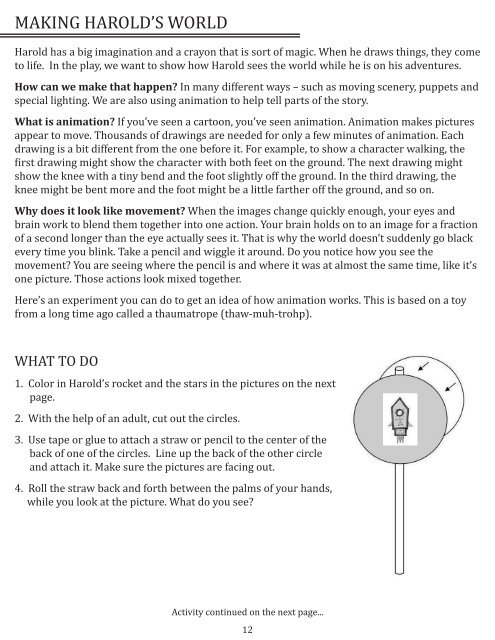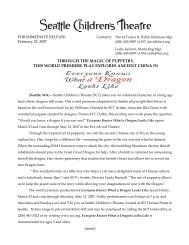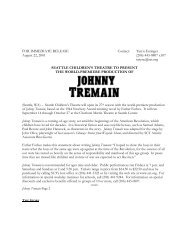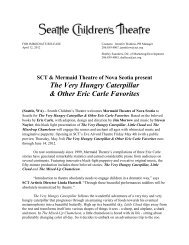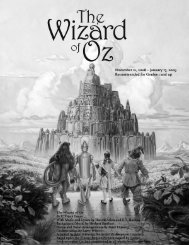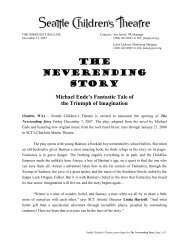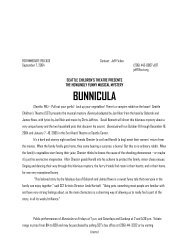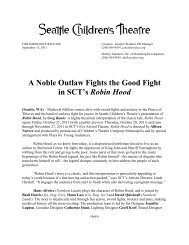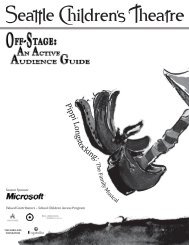Harold and the Purple Crayon - Seattle Children's Theatre
Harold and the Purple Crayon - Seattle Children's Theatre
Harold and the Purple Crayon - Seattle Children's Theatre
- No tags were found...
You also want an ePaper? Increase the reach of your titles
YUMPU automatically turns print PDFs into web optimized ePapers that Google loves.
MAKING HAROLD’S WORLD<strong>Harold</strong> has a big imagination <strong>and</strong> a crayon that is sort of magic. When he draws things, <strong>the</strong>y cometo life. In <strong>the</strong> play, we want to show how <strong>Harold</strong> sees <strong>the</strong> world while he is on his adventures.How can we make that happen? In many different ways – such as moving scenery, puppets <strong>and</strong>special lighting. We are also using animation to help tell parts of <strong>the</strong> story.What is animation? If you’ve seen a cartoon, you’ve seen animation. Animation makes picturesappear to move. Thous<strong>and</strong>s of drawings are needed for only a few minutes of animation. Eachdrawing is a bit different from <strong>the</strong> one before it. For example, to show a character walking, <strong>the</strong>first drawing might show <strong>the</strong> character with both feet on <strong>the</strong> ground. The next drawing mightshow <strong>the</strong> knee with a tiny bend <strong>and</strong> <strong>the</strong> foot slightly off <strong>the</strong> ground. In <strong>the</strong> third drawing, <strong>the</strong>knee might be bent more <strong>and</strong> <strong>the</strong> foot might be a little far<strong>the</strong>r off <strong>the</strong> ground, <strong>and</strong> so on.Why does it look like movement? When <strong>the</strong> images change quickly enough, your eyes <strong>and</strong>brain work to blend <strong>the</strong>m toge<strong>the</strong>r into one action. Your brain holds on to an image for a fractionof a second longer than <strong>the</strong> eye actually sees it. That is why <strong>the</strong> world doesn’t suddenly go blackevery time you blink. Take a pencil <strong>and</strong> wiggle it around. Do you notice how you see <strong>the</strong>movement? You are seeing where <strong>the</strong> pencil is <strong>and</strong> where it was at almost <strong>the</strong> same time, like it’sone picture. Those actions look mixed toge<strong>the</strong>r.Here’s an experiment you can do to get an idea of how animation works. This is based on a toyfrom a long time ago called a thaumatrope (thaw-muh-trohp).WHAT TO DO1. Color in <strong>Harold</strong>’s rocket <strong>and</strong> <strong>the</strong> stars in <strong>the</strong> pictures on <strong>the</strong> nextpage.2. With <strong>the</strong> help of an adult, cut out <strong>the</strong> circles.3. Use tape or glue to attach a straw or pencil to <strong>the</strong> center of <strong>the</strong>back of one of <strong>the</strong> circles. Line up <strong>the</strong> back of <strong>the</strong> o<strong>the</strong>r circle<strong>and</strong> attach it. Make sure <strong>the</strong> pictures are facing out.4. Roll <strong>the</strong> straw back <strong>and</strong> forth between <strong>the</strong> palms of your h<strong>and</strong>s,while you look at <strong>the</strong> picture. What do you see?Activity continued on <strong>the</strong> next page...12


